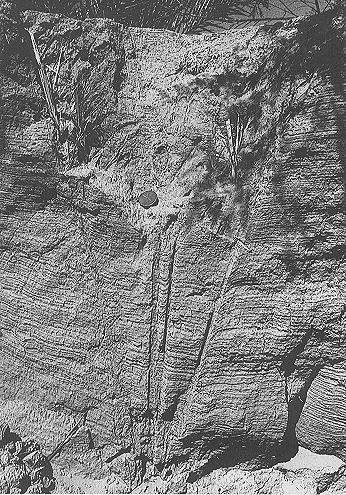
Vegetal (plant) trace fossils
Plate 147

Vegetal (plant) trace fossils
Plate 147
Specific types of trace fossils provide information on the sedimentary paleoenvironment: vertebrate tracks or marks of plant roots, for example, will indicate a continental or coastal environment. In marine sediments, certain types or assemblages of traces characterize distinct depths and can be used as paleobathymetric indicators. Caution is needed, however, in paleoenvironmental reconstruction: do not forget that biogenic structures represent modification processes, which can occur in the same environment of deposition or after a change of conditions. A marine sediment can be bioturbated after emergence; caused by tectonic uplift or sea level fall; the traces will then be made by continental organisms. On the other hand, a transgressed continental deposit will be overprinted with traces of marine organisms.
The picture shows a finely laminated lacustrine sediment crossed by subvertical, upward fanning traces left by the hollow stalks and foliage of a small palm tree (similar plants are rooted on the Modern soil: a glimpse can be caught in the background). Note the meniscus-shaped fill of the central hollow. The trace is a passive one, in this case: the plant left its mold on the sediment that buried it. Root traces are, instead, active, because this part of the plant disturbs the sediment (see color photo 6). Both active and passive traces, being preserved in place, are anyway indicative of environmental conditions.
Rhythmic seasonal deposits (arves ) of Oued Saura, Grand Erg Occidental, Algerian Sahara.
| Photo: G. G. Ori 1992. |